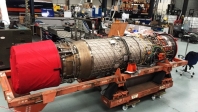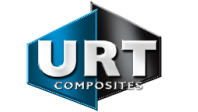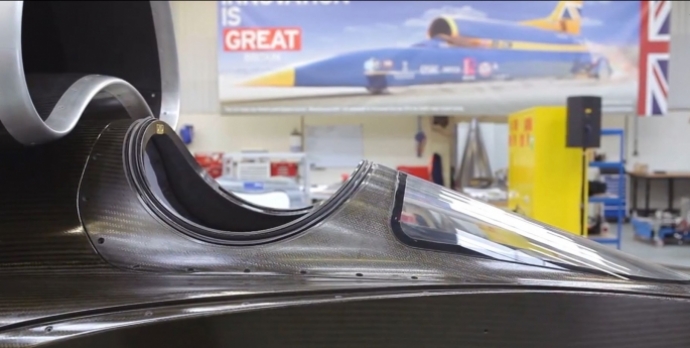
The BLOODHOUND SSC cockpit sits around a quarter of the way back along the Car, in front of the engines and just in front and underneath the jet engine air intake.
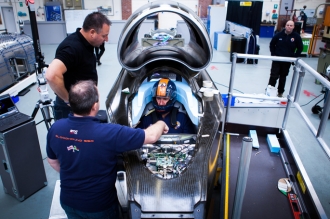
The cockpit has been custom-built to fit one person – Andy Green, BLOODHOUND’s driver. As such, it has been as carefully measured and designed as the rest of the Car, and is just big enough to hold the seat, screens, controls and steering wheel…and Andy.
Otherwise known as “Andy’s office”, everything possible has been done to minimise the potential discomfort caused by the extreme heat, sound and forces that will occur every time Andy drives the Car at high speeds. Indeed, the carbon fibre monocoque, of which the cockpit is part, will protect Andy from loads of up to 10 tonnes per square metre.
Canopy
The canopy above Andy’s office includes the windscreen plus a 500mm-wide hatch to let Andy get in and out of the Car. However, most importantly, it is a key aerodynamic element of the Car because it sits right in front of (and just below) the air intake for the jet engine.
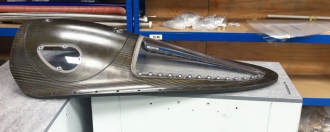
Although the Car may be travelling over 1,000mph, the jet engine needs the air that enters it to be travelling below the speed of sound, so under around 750mph, or otherwise the engine will ‘choke’ – this is known as a ‘surge’. The shape of the Car's nose and the canopy create shockwaves which blast the air up and away from the Car. Slow moving air bleeds off the back of the shockwave and into the air intake. The energy from slowing the supersonic air flow is dissipated into the cockpit as sound, which would, if not protected against, permanently damage Andy's hearing.
Because the canopy includes a removable hatch, this is fastened using latches able to withstand loads of 2.5kN (2.5 tonnes) to prevent it getting sucked into the jet engine intake.
Windscreen
The 25mm (1 inch) thick windscreen at the front of the canopy is made from two layers of acrylic that have been bonded together. Each layer is made from a block of solid acrylic that has been heated and stretched. It’s thicker – and therefore should be stronger – than the windscreen on a Eurofighter Typhoon jet and can withstand a 1kg bird hitting it at 1,000mph.
Although the screen is 25mm thick, it’s set in the Car at a very oblique angle because this is vital for the air flow into the jet engine intake. So Andy will be looking through approximately 50mm of solid plastic, which means it has to be optically virtually perfect.
Seat
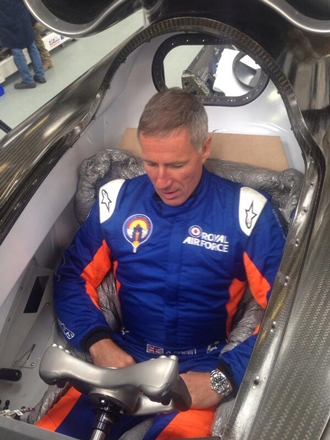
The seat has been moulded exactly to Andy’s shape by using a huge bag of polystyrene balls mixed with epoxy resin, in which Andy sat very still for 30 minutes while it set. This was then scanned with a laser scanner and used to produce a solid carbon seat.
Not only does Andy need to be able to get in and out of the cockpit, but he also needs to be able to see out of the front of the Car! Hence the seat has been positioned at the right height and angle to let Andy can see down the nose of the Car but low enough to give him head clearance inside the cockpit. The seat is virtually on the Car floor because Andy wants the seat upright to make it easier to cope with the forces he’ll experience at maximum acceleration and deceleration. It’s also been positioned so that he can reach the pedals comfortably with fairly straight legs.
Andy will be strapped into his seat using a five point Willans harness, with additional protection provided by a Pro Ultra HANS device to protect his neck and an Arai helmet.
Although BLOODHOUND may borrow from aircraft technology, one thing it is not borrowing is the idea of an ejector seat. Ejecting from a fast-moving vehicle at ground level is simply not an option – find out why in chief aerodynamicist Ron Ayers’ video.
Air supply
The cockpit carries a Camlock air supply, feeding clean breathing air to Andy through an ‘Adom’ mask, as used by RAF Typhoon pilots.
Pedals
The right-hand foot pedal controls the jet engine and will be used to start the Car moving, while the left-hand one controls the wheel brakes and will be used to slow the Car down from about 160mph.
Backup systems
With most of the controls dependent on battery power, there needs to be backup systems that allow Andy to stop the Car should all of the electrical systems fail:
- To the right of Andy’s seat is a mechanical lever. This is used to physically shut off the fuel supply to the jet engine.
- To the left of his seat are two levers which are attached to cables that run to the back of the Car. Andy can use these to deploy the parachutes manually.
Together, these mean that Andy can stop the Car from its very top speed by using the Rolex speedometer (which has its own separate battery and GPS) to tell him when to deploy the various braking mechanisms should the main computer fail for any reason.
Interior decoration
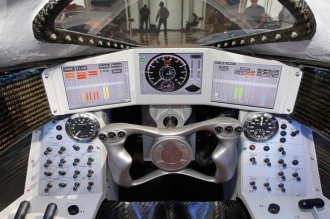
It’s vital that Andy can see everything inside the cockpit as easily as possible. Hence a lot of attention has been paid to maximising available light, but also providing optimum contrast. The interior is painted matt grey and instrument panels have been coated with special non-reflective paint to provide the best background colour against which to see the gauges and controls.
The Car also has interior lights, although this is for the benefit of the team preparing it before dawn.
Safety
The cockpit will include a fire suppression system which will douse the cockpit in foam should built-in infrared sensors detect naked flames.

